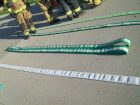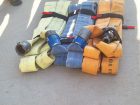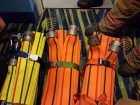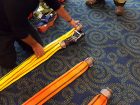
Features
Structural
Training
Back to Basics: Simplify the standpipe kit
Many fire-ground tasks can be accomplished by one firefighter during an emergency and in non-emergency situations. One single-firefighter task that is beneficial for small teams to understand is bundling of the standpipe or highrise kit.
August 24, 2017
By
Mark van
Deploying a standpipe or highrise kit always involves a minimum of three firefighters, but packing and prepping the hose kit for deployment can be accomplished by one firefighter.
I was involved with an evaluation process to determine which hose kit is best suited for standpipe operations. One aspect of the evaluation process was the proper repackaging of the hose kit after use on the fire ground. Recognizing that repacking the kit must be simple, so that one firefighter can complete the process, we modified the process. Along with the packing of the kit, there needed to be a similar deployment procedure – simple enough that a team of three firefighters can easily hook up the hose to the standpipe, flake the hose up to the fire floor/door, charge the hose with water, and then advance to suppress the fire.
The hose kit that was chosen after the evaluation is the FDNY highrise or standpipe kit – which originated within the Fire Department of the City of New York. As shown in photo 1, this kit comprises a 65-millimetre (2 ½-inch) hose packaged in three separate 15-metre (50-foot) bundles. The hose kit can also be used with 38-millimetre (1 ½-inch) or 45-millimetre (1 ¾-inch) hoses, as smaller hose loads make it easier for firefighters to carry the bundle up to the floor where it will be hooked up to the standpipe. It is my opinion that any standpipe or highrise operations should be conducted with a 65-millimetre hose for reasons discussed in previous columns.
If 30 metres (100 feet) are needed, then two bundles are taken. If 45 metres (150 feet) are needed, then three bundles are taken. The three bundles are packaged such that, when they are laid side by side, the couplings can easily be attached; this allows for easier staging of the equipment and personnel, while enabling firefighters to prepare for the operation once they are at the floor below the fire floor. With the couplings laid out side by side as shown on photo 2, a single firefighter can make the connections among the three bundles.
To pack the FDNY standpipe hose load, the hose must be laid out flat with the couplings at opposite ends. The firefighter grabs one coupling and walks it down to the other coupling, laying them side by side. The couplings should be in an FM orientation, meaning the female (F) coupling is on the right when facing the couplings, and the male (M) coupling is on the left (see photo 3).
At this point, the firefighter grabs the middle hose section where it has bended in half, and brings that section to the two couplings, laying it on top of the hose (see photo 4). The middle of the hose bundle can be marked with permanent marker or some other type of marking system. The mark easily identifies the middle of the hose – the point at which to grab when deploying the load.
Next, continue to stack the hose by grabbing the bended ends, walking them down to the coupling end, and folding on top of each other. Then, grab the coupling end of the hose and fold it on top of the hose load with the couplings facing toward the folded end. The couplings should be on top of the load and ready for strapping.
The three bundles are each held together with two quick-release straps, which are used to compress the load. One of the three hose bundles has the nozzle attached to the male coupling; the other two have exposed couplings.
The strapped bundles are ready store on the truck for deployment on the fire ground. This packing process is easy enough for one firefighter to perform any time and anywhere.
Mark van der Feyst has been in the fire service since 1999 and is a full-time firefighter in Ontario. Mark teaches in Canada and the United States and India and is a local-level suppression instructor for the Pennsylvania State Fire Academy, and an instructor for the Justice Institute of BC. He is the lead author of Residential Fire Rescue. Email Mark at Mark@FireStarTraining.com
Print this page



